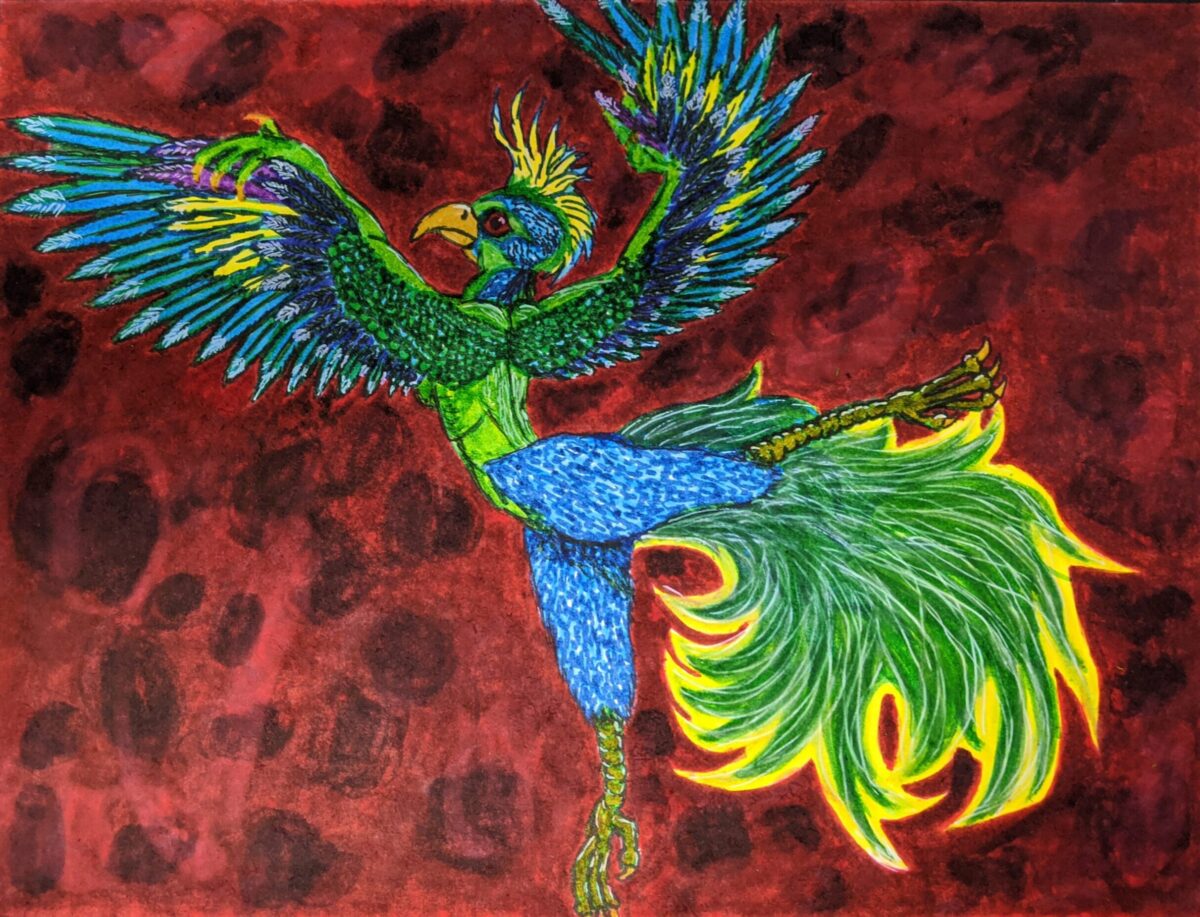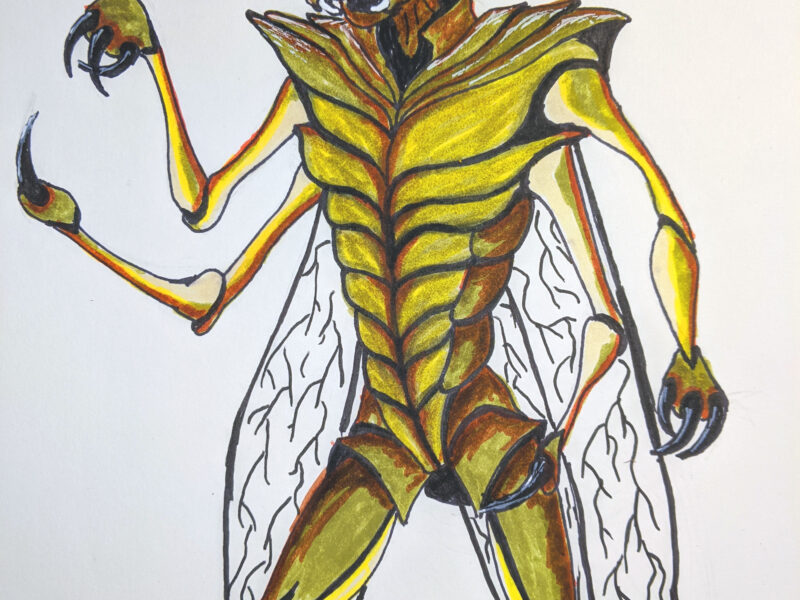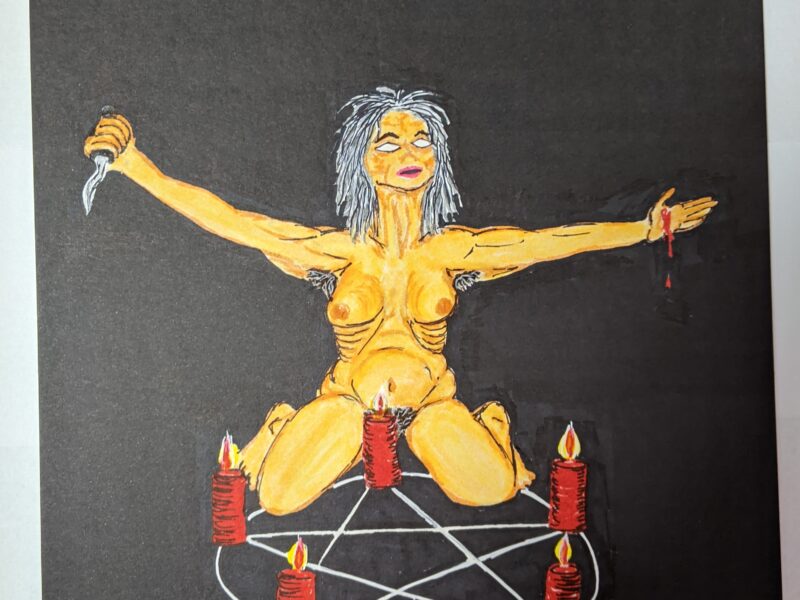Here is one that didn’t turn out as hoped. I really ate it on the background, but I like the image in general, especially in its color and imagination. Done in Brush Pens on paper, this 9×12 drawing of an anthropomorphized bird of paradise doing ballet is a fun image. Of course I ignored all science and let the female be the colorful version that dances…*ducks and looks around.
Here is a little history in anthropomorphized animals in art.
Anthropomorphized animals, or animals given human characteristics, have been a prominent feature in traditional art across various cultures throughout history. This artistic device has served numerous purposes, from storytelling and moral instruction to religious symbolism and social commentary. Here’s a closer look at the presence and significance of anthropomorphized animals in traditional art from different cultures:
Ancient Egypt:
- Deities: Many Egyptian gods were depicted with animal heads on human bodies. For example, Anubis, the god of mummification and the afterlife, was depicted with a jackal’s head, while Thoth, the god of writing and knowledge, had the head of an ibis.
- Symbolism: These representations were not merely artistic but carried deep symbolic meanings, often relating to the animals’ perceived characteristics. The jackal was associated with cemeteries, hence Anubis’s role in the afterlife.
Ancient Greece and Rome:
- Mythology: Greek and Roman myths are filled with stories of gods transforming into animals and vice versa. The centaur (half-human, half-horse) and the minotaur (human body with a bull’s head) are notable examples.
- Allegory: These mythological creatures often represented human traits or societal issues, such as the centaur embodying the conflict between civilization and barbarism.
Asia:
- Chinese Zodiac: The Chinese zodiac assigns animals to each year in a twelve-year cycle, with each animal embodying specific human traits. Artworks often depict these animals in human-like forms, especially during celebrations.
- Japanese Folklore: In Japanese art, animals like foxes (kitsune) and raccoon dogs (tanuki) are depicted with human traits. These creatures are believed to possess shape-shifting abilities and are often portrayed in ways that reflect human behaviors and emotions.
Middle Ages in Europe:
- Medieval Manuscripts: Illuminated manuscripts often featured marginalia with anthropomorphized animals engaged in human activities, such as playing musical instruments or participating in battles.
- Fables and Allegories: The medieval bestiary and fables like those by Aesop used anthropomorphized animals to convey moral lessons. Each animal character typically represented a specific human vice or virtue.
Native American Cultures:
- Totem Poles: Totem poles of the Pacific Northwest feature animals that are ancestral spirits or symbols of clans, often depicted with human attributes to convey stories and cultural beliefs.
- Mythology and Storytelling: In many Native American traditions, animals like the coyote, raven, and bear appear in myths with human-like intelligence and emotions, often serving as tricksters or cultural heroes.
African Art:
- Masks and Sculptures: In many African cultures, masks and sculptures often depict animals with human traits. These are used in rituals, ceremonies, and storytelling, embodying spirits, ancestors, and deities.
- Symbolic Meanings: Each animal depicted typically carries specific symbolic meanings, such as strength, wisdom, or fertility, and is used to teach social values or cultural heritage.
Modern Interpretations:
- Literature and Illustration: Books such as “Alice’s Adventures in Wonderland” and “Animal Farm” utilize anthropomorphized animals to explore complex human themes and social critiques.
- Animation and Film: Modern media, including animation and film, continue to use anthropomorphized animals to entertain and educate, with characters that appeal to both children and adults by reflecting human behaviors and societal norms.
Significance:
- Storytelling: Anthropomorphized animals make stories more engaging and relatable, especially for conveying moral lessons to children.
- Cultural Reflection: They often mirror the values, fears, and aspirations of the culture from which they originate, serving as a form of cultural expression and preservation.
- Symbolism: These representations allow for complex ideas to be communicated succinctly through recognizable traits associated with different animals.
In summary, anthropomorphized animals in traditional art serve multifaceted roles, from embodying religious and spiritual beliefs to offering social and moral commentary. Their continued presence in art highlights their enduring ability to bridge the gap between human experience and the natural world.



